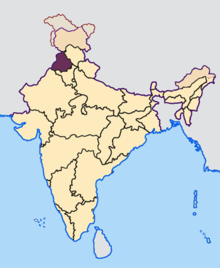Rakhri

Rakhri or Rakhrhee (Punjabi: ਰੱਖੜੀ) is the Punjabi word for Rakhi and the North Indian[1] festival of Raksha Bandhan is known as Rakhrhya in Punjabi. Rakhrhya are celebrated in the lunar month of Sawan on the full moon night,[2] according to the Punjabi calendar which is celebrated by many communities in the Punjab region.
Meaning
Rakhrhya celebrate the relationship between brothers and sisters. Rakhri means “to protect” whereby a brother promises to look out for his sister and in return, a sister prays for the well being of her brother. A Rakhri can also be tied on a cousin or an unrelated man. If a woman ties a Rakhri on an unrelated man, their relationship is treated as any other brother and sister relationship would be.
Celebration
A sister will tie the Rakhri on her brother and her brother will give a gift. There is no special ceremony but a sister will say something along the lines of:
ਸੂਰਜ ਛੱਡੀਆਂ ਰਿਸ਼ਮਾਂ
ਮੂਲੀ ਛੱਡਿਆਂ ਬੀਅ
ਭੈਣ ਨੇ ਬੰਨੀ ਰੱਖੜੀ
ਜੁਗ ਜੁਗ ਵੀਰਾ ਜੀਅ
[2]
Suraj chhadya rishma
mooli chhadya bi
bhain ne banni rahkhree
jug jug veera ji
History
_and_Porus_(oil_on_canvas).jpg)
The origins of Rakhri associate the tradition of tying a thread as starting with the Gods.[3] The festival was adopted by Brahmins in ancient times whereby they would visit people's homes to tie Rakhri and receive gifts.[4] The belief amongst Brahmins is that the Rakhri is a sacred thread and the one who wears it will be protected from snakes, ancestors' spirits, demons and all other evil.[5] The Rakhri is also tied on the wrist of a ruler by the royal priest. However, the festival was not traditionally a sisters-brothers festival.
Accordingly, there is no tradition verifying when the festival was adopted by the wider community for sisters to tie Rakhri on brothers.
Nevertheless, Rakhri is an ancient tradition which was in vogue in the Punjab region when Alexander the Great invaded ancient India in 326 BCE. Alexander the Great invaded the territory belonging to a local King named Porus who ruled over land between the Jhelum river and the Chenab river in the Punjab region.[6]
According to one legendary narrative, Roxana (or Roshanak, the wife of Alexander the Great) tied a Rakhri on Porus,[7] asking him not to harm her husband in battle. She crossed the Jhelum accompanied by hephaistion, Ptolemy and one other person.[7] The battle lasted an entire day and ended with great slaughter.[6] In accordance with tradition, Porus, a Katoch king, gave full respect to the Rakhri. On the battlefield, when Porus was about to deliver a final blow to Alexander, he saw the Rakhri on his own wrist and restrained himself from attacking Alexander personally.[8]
The Punjab region has been subjected to attacks over the centuries. As a result, women have sought protection from the local defending groups by tying Rakhris.[9] Consequently, it has become a custom for soldiers to receive Rakhris.
Other festivals
Solono
Rakhri coincides with the festival of Solono which is performed in honour of the good nymph Salone, who was instructed by Durvasa the sage, to bind Rakhis as charms to avert evil. Salone presides over the month of Sawan.
Brahmans and females alone are privileged to bestow these charmed wrist-bands. The occasion is also called Rishi Tarpani, the day on which to please the gods. On this occasion sisters and brothers exchange gifts.[5]
Nariyal Purnima
Nariyal Purnima or coconut full moon is celebrated in the Western Ghats that includes the states of Gujarat, Maharashtra, Goa and Karnataka. Here the day signifies the beginning of a new season for those dependent on the sea.[10]
Avani Avittam/Upakarmam
Avani Avittam is celebrated in the southern parts of India which include Kerala, Andhra Peadesh, Tamil Nadu and parts of Orissa and is an Important day for the Brahmins. The day is called Upakarmam by the Brahmins. They change their Holy threads on this day.[10]
Kajari Purnima
Shravani or Kajari Purnima is celebrated in Madhya Pradesh, Chattisgarh, Jharkhand and Bihar. The day is an important day for farmers who worship soil for giving life.[10]
Pavitropana
Pavitropana is observed in Gujarat when people perform the grand pooja or the worship of the three eyed God, Lord Shiva. It is the culmination of the prayers done through out the year.[10]
References
- ↑ The Hindu by A. Shrikumar 8 August 2014
- ↑ 2.0 2.1 Alop ho riha Punjabi virsa - bhag dooja by Harkesh Singh Kehal Unistar Book PVT Ltd ISBN 978-93-5017-532-3
- ↑ http://www.sikh-heritage.co.uk/festivals/rakshabandhan/rakhri.htm
- ↑ The Sikh World: An Encyclopedia Survey of Sikh Religion and Culture: Ramesh Chander Dogra and Urmila Dogra; ISBN 81-7476-443-7
- ↑ 5.0 5.1 Faiths, Fairs and Festivals of India by C H Buch ISBN 81-7167-614-6
- ↑ 6.0 6.1 Social and Cultural History of the Punjab Prehistoric, Ancient and Early Medieval by J.S.Grewal ISBN 81-7304-565-8
- ↑ 7.0 7.1 Porus: Itihasik novel. Surinder Singh Neki Star Books ISBN 9789350687246
- ↑ India cultures quarterly, Volume 25, School of Research, Leonard Theological College, 1968, 1968-01-01, retrieved 2011-08-16,
... They themselves took her to Porus and there she performed the ceremony of raksha bandhan ...
- ↑ http://adyargopal.com/rakshabandhan
- ↑ 10.0 10.1 10.2 10.3 http://www.raksha-bandhan.com/regional-significance.html
| ||||||||||||||
| |||||||||||||||||||||||||
